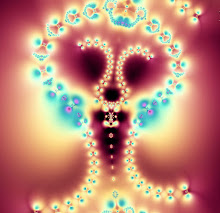Fractal created by Louise. Used Fractal Explorer
Bonsai is a Japanese version of the original traditional Chinese art penjing or penzai. Unlike penjing, which utilizes traditional techniques to produce entire natural sceneries in small pots that mimic the grandiose and shape of real life sceneries, the Japanese "bonsai" only attempts to produce small trees that mimic the shape of real life trees. Similar versions of the art exist in other cultures, including the miniature living landscapes of Vietnamese Hòn non bộ. It was during the Tang dynasty, when penjing was at its height, that the art was first introduced into Japan.
The loanword "bonsai" (a Japanese pronunciation of the original Chinese term penzai) has become an umbrella term in English, attached to many forms of potted or other plants, and also on occasion to other living and non-living things. According to Stephen Orr in The New York Times, "the term should be reserved for plants that are grown in shallow containers following the precise tenets of bonsai pruning and training, resulting in an artful miniature replica of a full-grown tree in nature." In the most restrictive sense, "bonsai" refers to miniaturized, container-grown trees adhering to Japanese tradition and principles.
Purposes of bonsai are primarily contemplation for the viewer, and the pleasant exercise of effort and ingenuity for the grower. By contrast with other plant cultivation practices, bonsai is not intended for production of food or for medicine. Instead, bonsai practice focuses on long-term cultivation and shaping of one or more small trees growing in a container.
A bonsai is created beginning with a specimen of source material. This may be a cutting, seedling, or small tree of a species suitable for bonsai development. Bonsai can be created from nearly any perennial woody-stemmed tree or shrub species that produces true branches and can be cultivated to remain small through pot confinement with crown and root pruning. Some species are popular as bonsai material because they have characteristics, such as small leaves or needles, that make them appropriate for the compact visual scope of bonsai.
The source specimen is shaped to be relatively small and to meet the aesthetic standards of bonsai, which emphasizes not the entirety of grand sceneries but rather only the tree itself. When the candidate bonsai nears its planned final size, it is planted in a display pot, usually one designed for bonsai display in one of a few accepted shapes and proportions. From that point forward, its growth is restricted by the pot environment. Throughout the year, the bonsai is shaped to limit growth, redistribute foliar vigor to areas requiring further development, and meet the artist's detailed design.
The practice of bonsai is sometimes confused with dwarfing, but dwarfing generally refers to research, discovery, or creation of plants that are permanent, genetic miniatures of existing species. Plant dwarfing often uses selective breeding or genetic engineering to create dwarf cultivars. Bonsai does not require genetically dwarfed trees but rather depends on growing small trees from regular stock and seeds. Bonsai uses cultivation techniques like pruning, root reduction, potting, defoliation, and grafting to produce small trees that mimic the shape and style of mature, full-size trees.
Aesthetics
Bonsai aesthetics are the aesthetic goals characterizing the Japanese tradition of growing an artistically shaped miniature tree in a container. Many Japanese cultural characteristics, in particular the influence of Zen Buddhism and the expression of Wabi-sabi, inform the bonsai tradition in Japan. Established art forms that share some aesthetic principles with bonsai include penjing and saikei. A number of other cultures around the globe have adopted the Japanese aesthetic approach to bonsai, and, while some variations have begun to appear, most hew closely to the rules and design philosophies of the Japanese tradition.
Over centuries of practice, the Japanese bonsai aesthetic has encoded some important techniques and design guidelines. Like the aesthetic rules that govern, for example, Western common practice period music, bonsai's guidelines help practitioners work within an established tradition with some assurance of success. Simply following the guidelines alone will not guarantee a successful result. Nevertheless, these design rules can rarely be broken without reducing the impact of the bonsai specimen. Some key principles in bonsai aesthetics include:
- Miniaturization: By definition, a bonsai is a tree kept small enough to be container-grown while otherwise fostered to have a mature appearance.
- Proportion among elements: The most prized proportions mimic those of a full-grown tree as closely as possible. Small trees with large leaves or needles are out of proportion and are avoided, as is a thin trunk with thick branches.
- Asymmetry: Bonsai aesthetics discourage strict radial or bilateral symmetry in branch and root placement.
- No trace of the artist: The designer's touch must not be apparent to the viewer. If a branch is removed in shaping the tree, the scar will be concealed. Likewise, wiring should be removed or at least concealed when the bonsai is shown, and must leave no permanent marks on the branch or bark.
- Poignancy: Many of the formal rules of bonsai help the grower create a tree that expresses Wabi-sabi, or portrays an aspect of mono no aware.









0 Comments:
Post a Comment